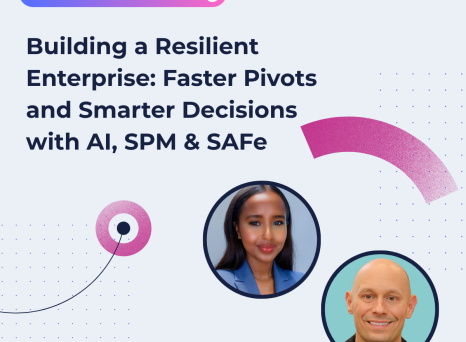What is the Agile methodology?
Often referred to as simply “Agile,” Agile methodology is a project management and product development framework. Its core focus is iterative improvement — the project team starts with a simple design and adds functionalities through short iterations (sometimes referred to as “intervals” or “sprints”) after each project phase.
Agile is most commonly deployed as a software development method, with opportunities for gradual improvement highlighted throughout a project’s lifetime. It promotes a highly collaborative atmosphere, encouraging face-to-face communication and the breaking of silos.
With this emphasis on flexibility and fluidity, agile project management methodologies are often contrasted with waterfall methodologies, which promote a linear and sequential approach.
While there is no single creator of agile methodologies, it was first outlined in 2001 by 17 software developers in the Manifesto for Agile Software Development. This is more commonly referred to as The Agile Manifesto. There are four values that are key to expressing the agile methodology.
The Agile Manifesto: What are the 4 values of agile methodology?
The Agile Manifesto outlines four values of Agile. These form the foundation of Agile and should inform project decisions.
1. Individuals and interactions over processes and tools
Agile prioritizes people over processes to eliminate rigid structures, timelines, and bottlenecks. This enables greater flexibility and a focus on communication and collaboration.
2. Working products over comprehensive documentation
Agile prioritizes the delivery of working, usable software. This ensures the creation of a tangible product alongside the opportunity to grow and develop it.
3. Customer collaboration over contract negotiation
Including customers in product development is at the core of Agile. The process should be people-centric rather than product-centric. This means that a product evolves based on user feedback rather than adhering to a detailed contractual outline.
4. Responding to change over following a project plan
The Agile methodology turns the product plan into an evolving document. The roadmap at the start of the project may look very different six months in. And this is a good thing, especially in the current volatile climate. Project teams can pivot in response to uncertain economic circumstances, resourcing issues, or increased competition.
What is scrum in agile project management?
Scrum is a type of agile, lightweight project management framework. Popular for its versatility and simplicity, it uses 30-day iterations (“sprints”) and small, self-organizing teams of 4 to 9 members to deliver functional software with the highest business value.
Each team meets daily—the daily scrum—to evaluate accomplishments since the previous meeting and to highlight obstacles that may need escalating or prioritizing.
What is kanban in agile project management?
Kanban is another framework for the Agile methodology. A Japanese word that translates as “signboard,” Kanban is characterized by the use of multi-column boards to visualize project workflows and progress. Work items are represented by cards, which can be moved along the Kanban board as progress is made.
Kanban is a simple, highly-visual system and framework that can work particularly well for remote teams, giving all team members an instant overview. In fact, many teams employ this agile framework without even realizing.
Is Agile methodology suitable for all projects?
There is no one-size-fits-all approach to developing any product or undertaking any project. Agile methodologies mainly suit complex projects, such as software development, but you can apply its principles to any project that requires flexibility and collaboration.
That said, there are some examples where other methodologies may be preferable, particularly if you have a strict deadline, work with sensitive data, or have a very large team to coordinate.
- If the project has a clear deadline and established set of requirements, it may be too rigid or inflexible to realize the benefits of agile methodologies. Instead, a more standardized approach may be better suited.
- If senior leadership is not ready for an organizational shift to Agile, or the project’s risk tolerance is too low, it may not be the right time. After all, Agile methodologies are most effective when an entire organization adopts them. It requires the right setup, clear roles and a commitment to autonomy. Ask yourself: are stakeholders interested in adopting an Agile approach? Could my project benefit from it? If so, now might be the time to build a business case for it and try it.
- If gathering ongoing feedback is challenging, other methodologies may be more suitable. If gathering ongoing feedback is challenging, other methodologies may be more suitable. For instance, in the pharmaceutical industry, where highly regulated products or sensitive data are common, Agile’s iterative feedback approach may not be practical. In such scenarios, other methods that don’t rely on frequent customer and stakeholder feedback might offer better outcomes.
- The larger the team, the more challenging the coordination with agile methodologies. After all, Agile works best with small groups collaborating seamlessly across multiple teams, as larger groups require more coordination and thus complicate the iterative process.
A dynamic PPM software solution will be able to manage multiple methodologies—Agile, Waterfall, and a hybrid approach.
What are the benefits of agile methodology in project management?
An Agile approach benefits your team, organization, and end user by empowering you to quickly develop and roll out a usable product. Then, the focus is on scalability, improvements, and developments.
- Agility empowers teams to collaborate on common, strategic goals. The idea is to work without rigid structures and confinements. Teams communicate regularly and respond quickly to market and consumer changes, ensuring continuous improvement with every iteration of the product or project. Regular communication also reduces confusion and mitigates siloed working.
- Agility ensures better product quality by adopting an iterative approach. Processes are assessed and improved after each phase, with the focus always on improvement.
- Organizations can enjoy a faster time to market by prioritizing a viable product over a perfect or comprehensive one. This reduces initial costs, helps prioritize resources, and enables early intervention to mitigate risks.
- It is an adaptable, risk-averse project methodology. With no strict deadlines on project deliverables, agile teams can respond to change quickly. Regular assessment of the product ensures issues can be remedied quickly before they may endanger the its success.
- Agile project management enables you to design a product tailored to your audience’s needs. These methodologies rely heavily on customer feedback and input, essentially involving your users in the development process. By engaging this key stakeholder throughout, the end product will be more bespoke to their expectations and needs.
- It is predictable and consistent. Each phase, interval, or sprint is at a fixed time period, making it easy for managers to measure performance and manage resources.
Many organizations already employ Agile principles without realizing it. To find out if your team is on the right track, check out our 5 signs you’re halfway to becoming Agile.
At Planisware, we support your Agile journey with integrated Kanban boards, sprint assignments, project roadmaps, and more, keeping all your activities organized in one place.


